The workshop: ESP USA
We take a tour around the Japanese guitar giant's US home
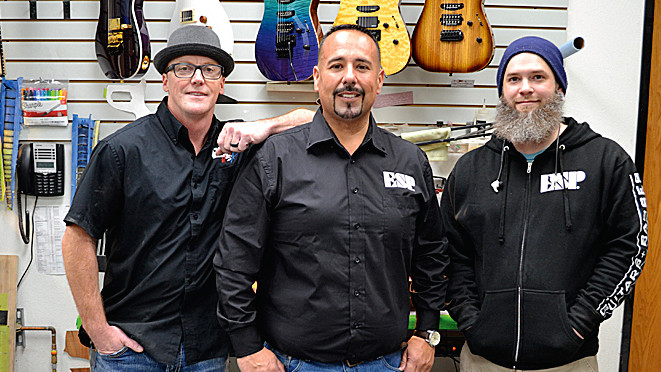
What happens when you take exacting Japanese guitar design and craft it in California, the spiritual home of the electric guitar? We meet the elite luthiers of the ESP USA workshop to find out...
Tucked away amid the anonymous industrial units surrounding the Bob Hope Airport in Hollywood, some sleek machines are taking flight. These ones have strings rather than wings, admittedly, but they look fit to break the sound barrier nonetheless.
The ESP Guitar Company has always built guitars to an exacting standard, but the instruments built at its unique US workshop positively glow. Stepping inside, we admire the deep, lustrous, mirror-flat finishes over quilted maple that adorn the finished guitars on display. Looking more closely, we also note the perfectly finished frets and sculpted heels that add function to the beautiful form of these high-spec instruments.
The guitars built here in Hollywood are available in a bewildering array of finishes, specs and tonewoods
It’s no surprise, then, that the cadre of luthiers working at the ESP USA workshop are very proud of their work. But that pride is based upon more than just the quality of the guitars that are built here. ESP has a carefully tiered range and only the very top echelon of guitars built by the company as a whole actually wears the ESP logo on the headstock, with the premium E-II range and workhorse LTD line forming the bulk of the company’s output.
For ESP to grant full title to the instruments built here, in California, was thus a big step for the Japanese company, which put the fledgling shop under heavy scrutiny during its early days to ensure that the quality lived up to the name. Furthermore, it gave an unusual role to ESP USA workshop: building highly configurable versions of standard models.
While these stop short of full customs, which are the preserve of ESP’s Japanese workshop only, the guitars built here in Hollywood are available in a bewildering array of finishes, specs and tonewoods via a Configurator tool on the ESP USA website, making them a great choice for players looking to combine top quality with a touch of individuality.
With coffee in hand, then, we sat down with Miguel Soto, international sales manager; Greg Burnett, the operations and final assembly manager; plus Ryan Dominguez, the paint department supervisor who conjures up a dazzling spectrum of finishes for the ESP guitars.
Get the MusicRadar Newsletter
Want all the hottest music and gear news, reviews, deals, features and more, direct to your inbox? Sign up here.
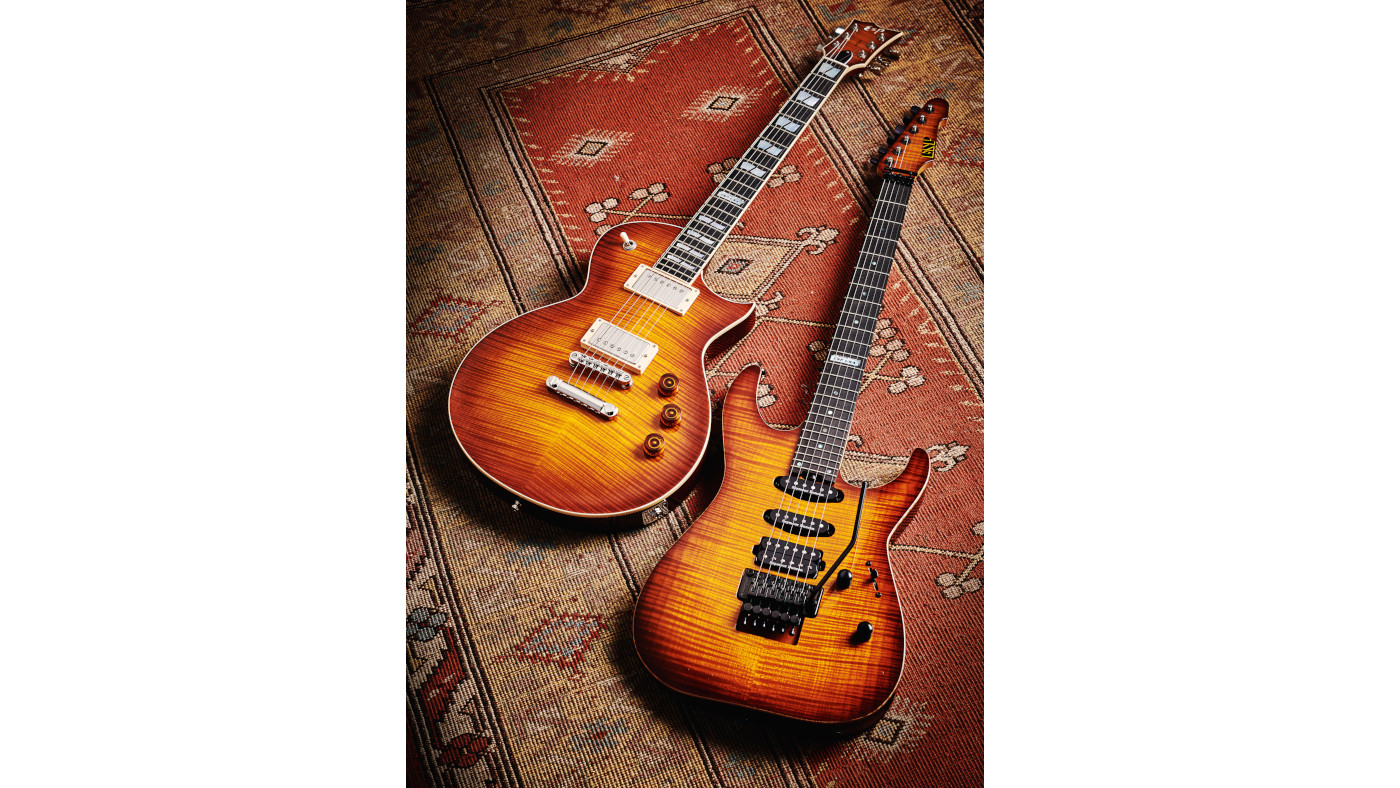
East to West
Outside of Japan, this is the only workshop permitted to use the coveted ESP name on the headstock. How did ESP USA come into being?
Greg Burnett: “As far as the role we fill goes, we saw value in a USA-made instrument. That was the president’s vision for what we’re making here - it’s about low numbers and high quality: limited productions.
“We weren’t trying to crank out as many guitars as possible, because sometimes quality can slip if you’re trying to force stuff through. So we kept it small for a reason. And, sometimes, that can be hard to manage, as far as capacity goes. We only have, like, six full-time guys that are working on these guitars, so that’s why we’re [deliberately] limiting the quantities that we’re making every month.
Asia has a really big US-built market, so a lot of companies, even Asian manufacturers, will have a US-built line so they can sell over there
“We have a very high standard to live up to; ESP Japan sets that standard. I think everybody in the world knows they have very high standards for quality, and, hence, they have a [substantial] price tag attached to that.
“As far as the differences between the [Japan-based] Custom Shop and us go, this shop fulfils a desire for USA-made instruments. That demand’s coming from Europe and Asia especially. Asia has a really big US-built market, so a lot of companies, even Asian manufacturers, will have a US-built line so they can sell over there - it’s a big thing. I think that’s the role we fit.”
How do your guitars differ from those of the Custom Shop in Japan?
GB: “We have a wonderful custom shop in Tokyo that takes care of any [pure] custom orders and builds. But what we offer here are customisable selections in terms of tops and top woods, plus we have a couple of different choices of fingerboards, things like that. Then there are lots of options on finishes and pickup configurations. Ryan [Dominguez], our painter, puts his own unique twist on how the guitars look and it adds a lot of creativity to the shop.”
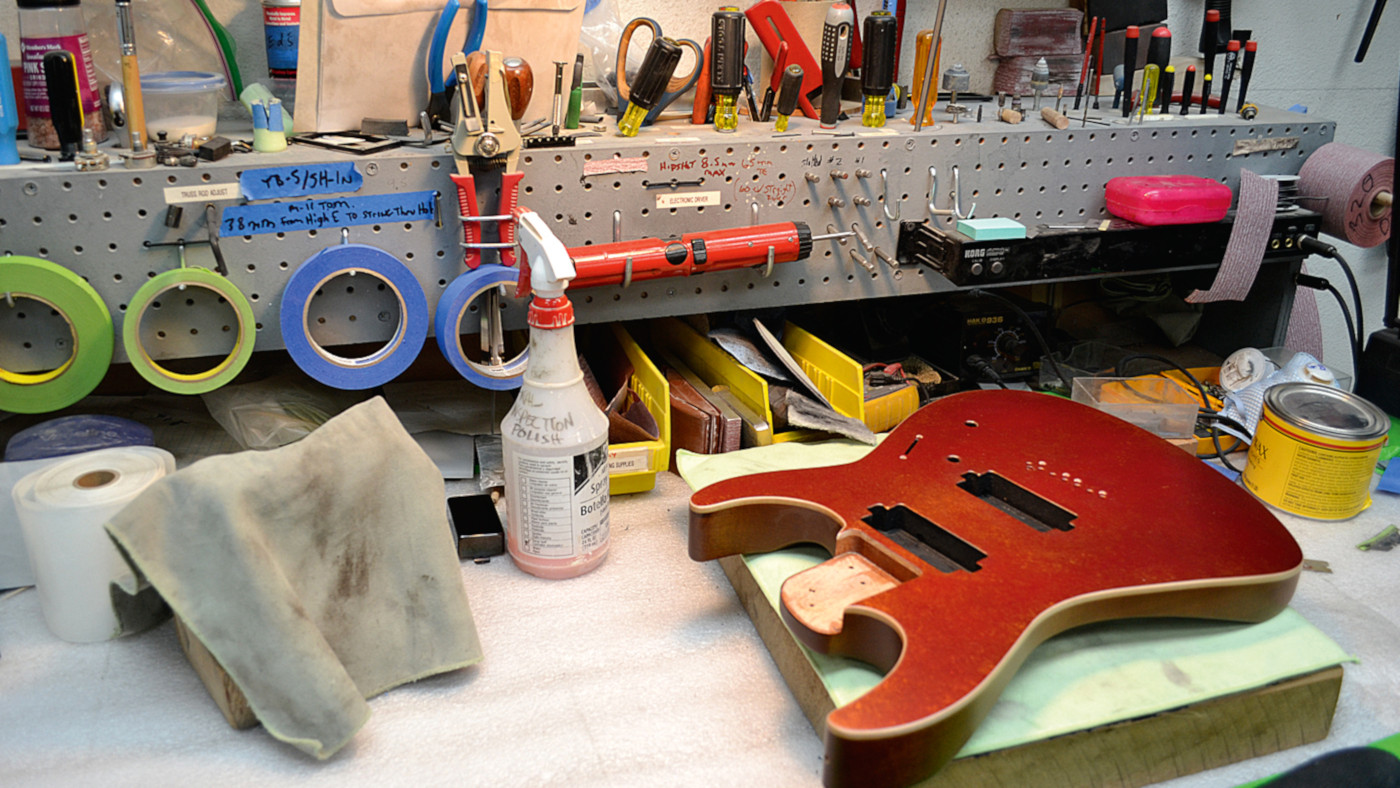
Do you find ESP customers more willing to experiment when it comes to unique finishes and body styles than fans of, say, traditional Gibson and Fender electrics?
Ryan Dominguez: “Yes. I’d say probably they’re a little bit more open to the not-so- standard finishes you see. Maybe because the Japanese have done a bunch of crazy things we’ve been known for in the past. You get your kamikaze finishes and so on, you know? So I think they’re not only more receptive, but it’s kind of expected of ESP to have bolder finishes than what you would see from other manufacturers.
“I’ve always been a big fan of Japanese culture, pop culture - the colours they use for animation. Even as a kid, animation was always kind of a thing for me. So I think my inspiration just comes from the usage of different colours. How they contrast to themselves and, even if they clash, if it looks good I think that’s valid.
“I’m lucky enough to have the creative freedom to come up with whatever... Every now and then we have to run it by the higher-ups if there’s something a little too wacky that we think maybe won’t fly right away. But they usually sign off on it.
“We’ve done guitars in the past where we’ll wing it and I’ll come up with the colour on the spot and it’ll find its way into production. The colour is either well received by the public or by the higher-ups, the president, vice- president, you know? So they’ll eventually work that into a limited run on something - or just a standard production colour.”
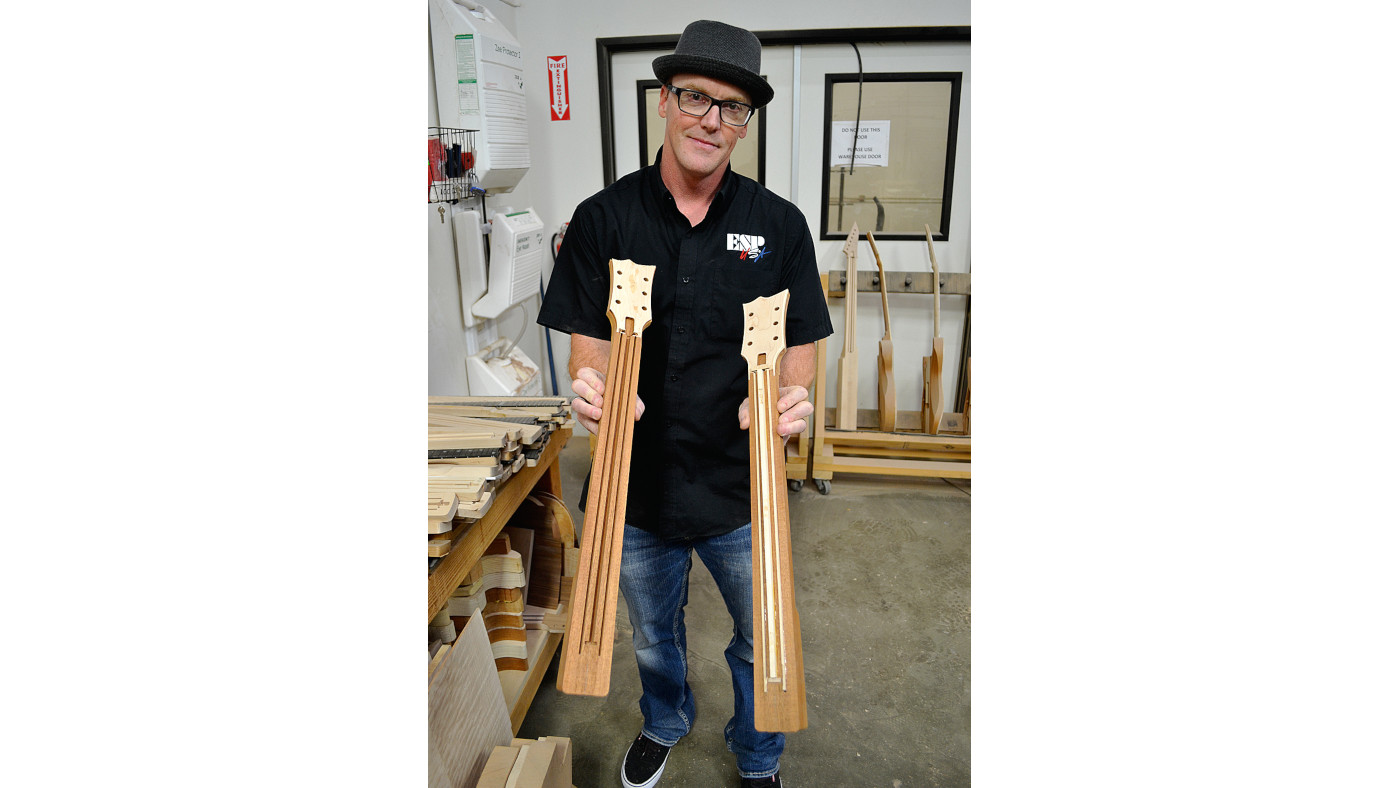
Woodshop
What are the typical tonewood combinations used for ESP guitars?
GB: “In terms of what we do specifically in this ’shop, I would say it’s your quilts and plain tops on a mahogany back - and that’s kind of a classic combination of tonewoods right there. Ryan has started doing some open-grain finishes on ash, too. Ash is a time-tested, proven tonewood that sounds really good on its own, especially when you let the wood vibrate and you’re not sealing it up.
“So while that is probably the most simple thing we do, it’s also the coolest, to me. Because I was a guitar player first, before I worked on the things, and I love the way they sound, I love the way they feel when you play them.
What we’re after here is something classy that’s still founded somewhere in our roots, with the maple tops, you know? That’s what we do
“We have a nice blend of [classic tonal elements] to work with. Certain models have a maple neck with a mahogany body and then topping that off with maple - you get a nice blend of the brighter with the more mid-focused tonewoods. What we’re after here is something classy that’s still founded somewhere in our roots, with the maple tops, you know? That’s what we do.
“We’re branching out a bit these days, but as far as getting into anything really crazy or ‘out there’ goes, we’re still letting the Custom Shop cover that territory, though we’re slowly working our way in. When we first started, we offered three models with three different colours on each of those models and that was it.
“So we’re really set up to be a production shop. But as we saw the need to add more options, and people were requesting this and that, and whether it’s a different top or a fingerboard wood on a certain model, or pickup configurations when we started having that - we saw the value in having those options while still sticking within a framework where people had set parameters to pick from.”
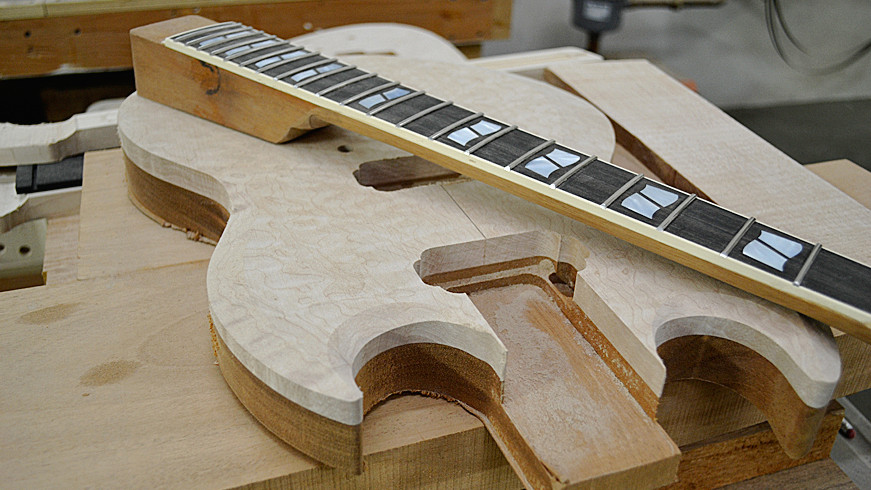
ESPs are known for their slippery, shred-oriented playability. But is there also something for more traditional players?
GB: “Oh, yes. I mean, we’re not making super-fast shredder setups here, as far as our necks go or anything. Maybe our ‘7’ feels a little bit more along those lines... but we’re using a 12-inch radius fingerboard, which is not a super-flat fingerboard - it’s a very comfortable fingerboard to play.”
What kind of neck profiles are most in demand? Is the trend toward fatter necks than in the glory days of 90s shred?
GB: “We’re sticking to our traditional neck shapes. We have a ‘Thin U’, then we have an ‘Ultra-Thin U’. It’s a matter of a couple of millimetres between the two.”
Miguel Soto: “Our neck profiles are kind of matched to the aesthetic of the [body] shape. For instance, if you’re going for an Eclipse, you can have a neck that’s a little bit wider. People are more accustomed to having a little bit [of a] thicker neck on our single-cut bodies. By comparison, our bolt-ons are going to be a little bit thinner, especially for anything that has a Floyd Rose. Those have a thinner profile, so they’re a little bit easier to get around on, speed-wise.”
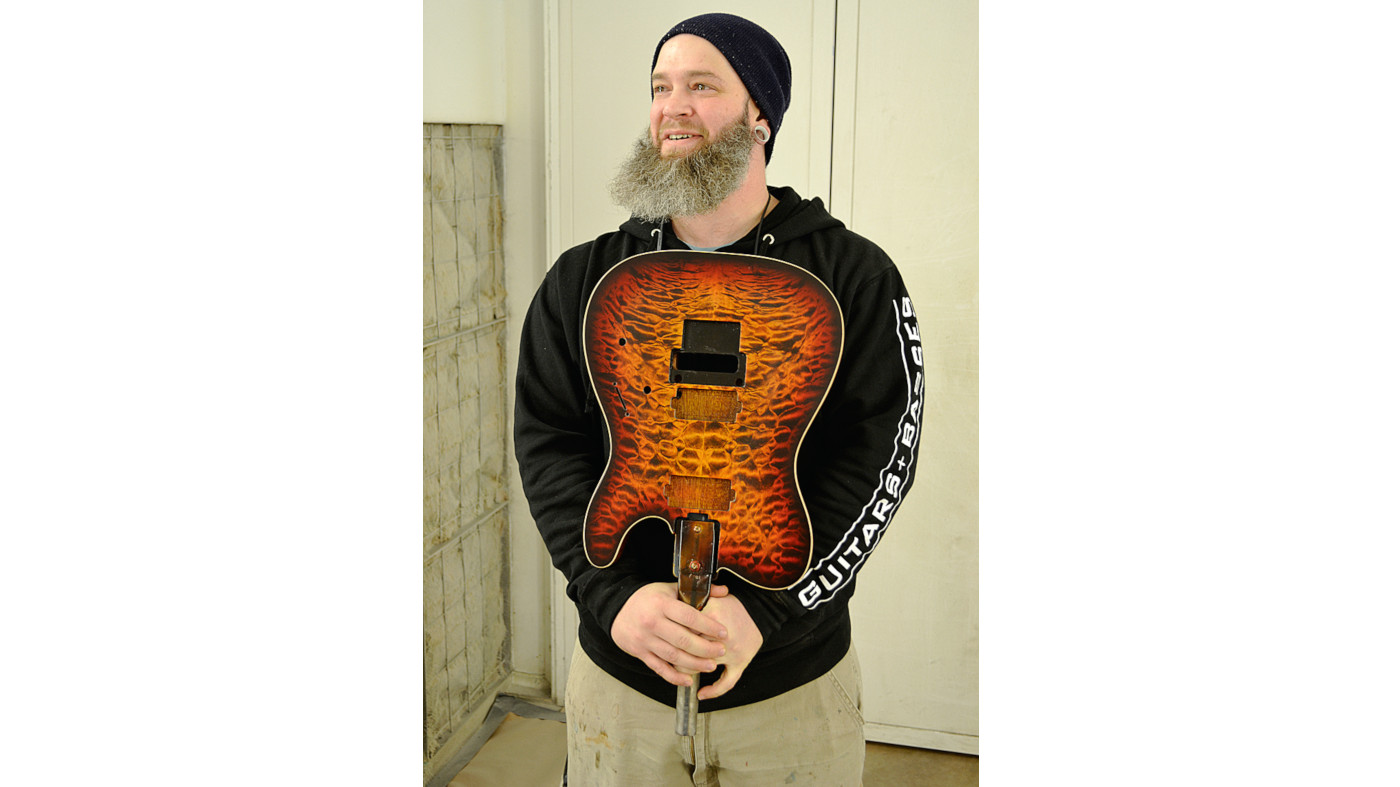
Picking it up
Do you use Gibson and Fender-style scale lengths for your set-neck and bolt-on guitars, respectively?
GB: “Yes. Our Viper, which is your SG-style model, has a 24.75-inch scale - and it’s the same on the Eclipse. But our more shred- worthy, or heavy metal-style guitars, are going to have a 25.5-inch scale.”
Do you fit a standard set of strings to all of the guitars that are built here?
GB: “On the shorter scale guitars, like the Eclipse or Viper, we use a 10 to 46 gauge set. On our longer scale guitars, the 25.5-inch scale instruments, we’re doing nines to 42s.”
The heels on your set-neck models are really beautifully blended in with the body. Is that a special neck joint?
You don’t have to worry about that neck joint failing, because ours has a substantial amount of meat
GB: “Yes. On the set-neck models, like an Eclipse, it’s not your standard neck joint where it’s a small tenon that slots in and the fingerboard’s glued down on top of that. Ours are in there quite a way: they extend almost halfway into the front half of the guitar. With that much meat getting glued into the body, you’re able to contour that neck out and get that smooth feel to help blend it in. You don’t have to worry about that neck joint failing, because ours has a substantial amount of meat, which is also going to change the tone of the guitar as well and increase that sustain. And if you have a clean neck joint, a tight-fitting neck joint, then it’s going to sound that much better. You don’t really lose anything to gaps.”
ESP used to be associated with the ubiquitous EMG active pickups. Is that still the case these days?
GB: “Just lately, it seems people have been more geared towards Fishman, Bare Knuckle. Those two companies have been setting the standard for your high-gain, high-output, metal or heavy rock...”
RD: “But on the whole, we do about half and half between Seymour Duncans and EMGs. I don’t think we see one more than the other. It’s pretty even across the board...”
GB: “Of course, there are pockets. But when you look at three years’ production or so, I’d say it’s maybe a 60/40 split between EMGs and Seymour Duncans, between active and passive. But we are offering some Fishman [Fluence] pickups here. We did make one for NAMM with the Fishmans in it, and we were going with the Modern set. We just thought those would fit what we do here. I’m excited about them.
“I was sceptical at first, like, ‘How much different do they sound?’ But, honestly, hearing them... I’ve done a lot of A/B, working with artists throughout the years, and developing my ear to where I can hear certain things that I never thought I’d be able to hear. And you can really hear it - it’s just a great-sounding pickup. Very dynamic, there’s a lot to them.”
Jamie Dickson is Editor-in-Chief of Guitarist magazine, Britain's best-selling and longest-running monthly for guitar players. He started his career at the Daily Telegraph in London, where his first assignment was interviewing blue-eyed soul legend Robert Palmer, going on to become a full-time author on music, writing for benchmark references such as 1001 Albums You Must Hear Before You Die and Dorling Kindersley's How To Play Guitar Step By Step. He joined Guitarist in 2011 and since then it has been his privilege to interview everyone from B.B. King to St. Vincent for Guitarist's readers, while sharing insights into scores of historic guitars, from Rory Gallagher's '61 Strat to the first Martin D-28 ever made.












